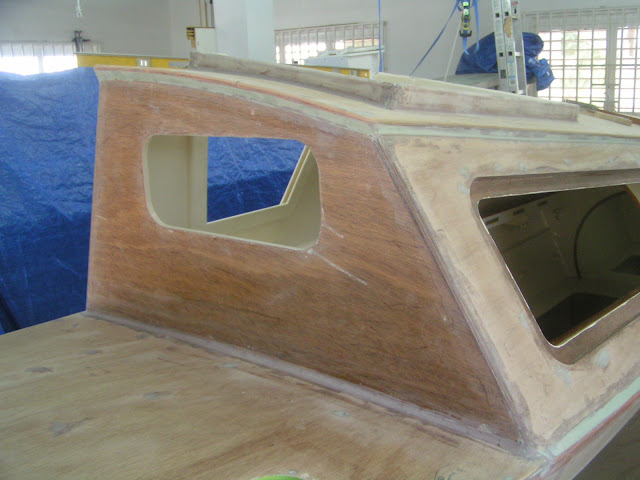This September marks three years since the boat materials arrived. Since then I have spent most everyday, in social isolation, working away making plywood sheets into the larger boat structure. The social isolation was good training for the Trump Flu that has put everyone in isolation. As I trend high on the introvert scale, social isolation is not a hardship for me.
Out of the 37 full sheets of plywood received, only six remain full sheets. I'm on the last five epoxy gallons of the twenty estimated to complete the boat. More materials are needed but current situations place obstacles in the path to obtain additional materials. This does not yet impede progress as much remains to be done with the structures and materials on hand.
Chocolate brown epoxy fillets ease the surface transitions that the fiberglass must conform to.
Sanding and an application of the green fairing compound, followed by another sanding, completes the fillets.

The bow and stern receive fillets.
A bit of sanding and the stern is ready for fiberglassing.
Forward and aft cabin ends (as well as the sides) received a roof line brow that protrudes 3/8 of an inch from the cabin surfaces. The brow feature is copied from the larger Tiki 38 version. The brow adds a shadow line that emphasizes the curving roof and echos the crossbeam curve that will be mounted on the deck below. I think it gives the hull a very jaunty look.
This is the inboard side of the starboard hull with parts of the washboard closing up the companionway. The cabin side slopes so that any water between the washboard and the cabin side can pool at the bottom. It is difficult to see, but weep holes are made near the bottom corners to allow the water to drain away and help prevent rot. Weep holes are also visible at the top on either side of the companionway opening.
Above is a closeup of the forward weep hole at the top of the companionway opening. Water can leak into the gap between the roof and the opening cover (shown moved to the right). The roof slopes so that water will drain towards the cabin interior. A rasp was used to create a sloping groove that will direct water down the cabin side rather than inside. I more rasp work sloping will be required to assure this will work correctly. Multiple fiberglass applications to these intricate surfaces will be necessary for waterproofing.

The bow and stern receive fiberglass in multiple applications. The fiberglass is applied to the sides and the epoxy is allowed to cure. The fiberglass is then trimmed and sanded to taper the edges. The tapered edges help blend in the following fiberglass applications that cover the edges and other features.
The starboard deck, cabin and shear stringers now sport fiberglass protection. Covering the shear stringers required fiberglass cut on the bias to conform to the shapes. It was a hell of a time for my orbital sander to disintegrate, but I soldiered on; sanding by hand as much as needed to accept the next fiberglass application. When it was all covered I was fortunate to locally source a new orbital sander. My lesson with this was that it is better to sand the day after the fiberglass was applied than to delay and sand the fully hardened epoxy at a later time.










